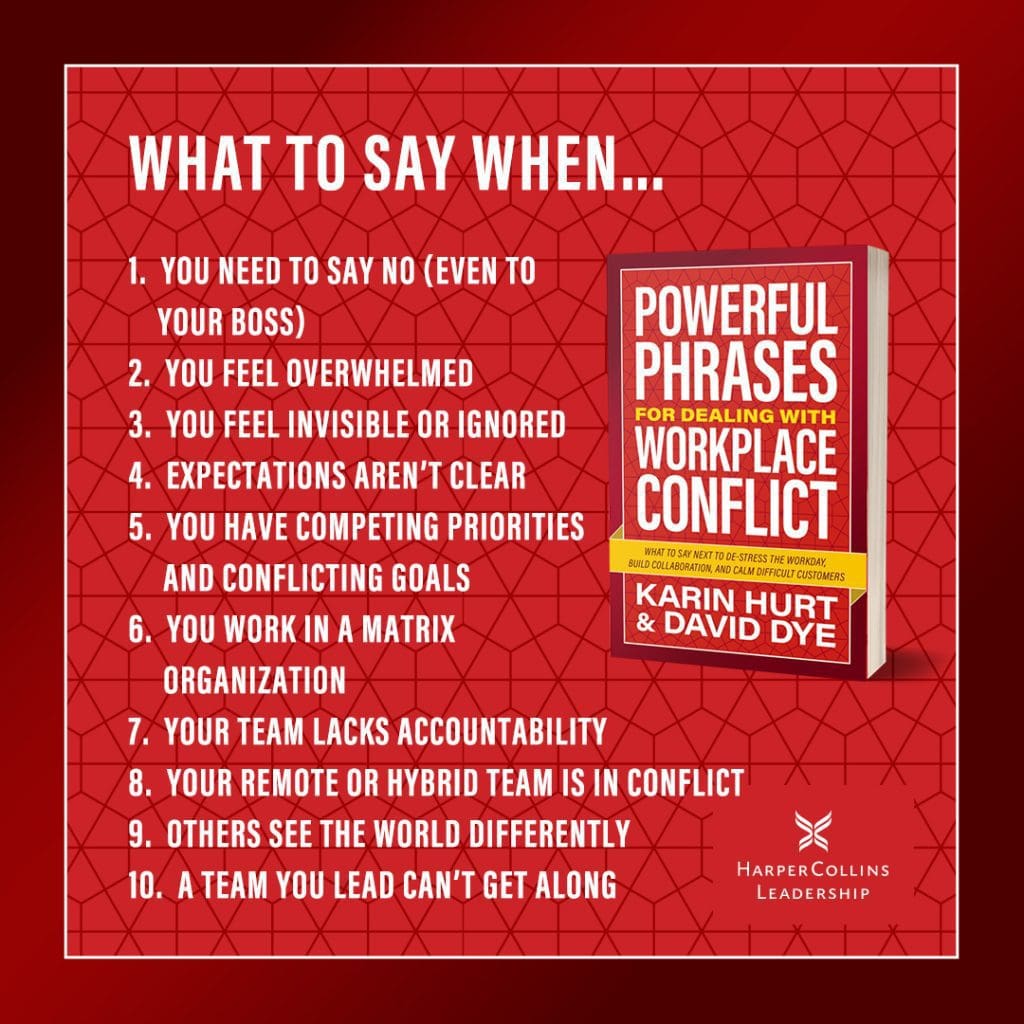Handling team conflict well distinguishes outstanding leaders
You’ve got a clear focus on what matters most. Your team seems to work well together, but then you get that call: “I need to talk to you about …” or a team member suddenly explodes at their teammates and storms off the floor. It’s conflict, a disagreement, or a clash of personalities. Handle it well and you’ll build trust and influence. But ignore it or respond poorly and not only do you lose trust and credibility, but the conflict distracts your team from the work that matters most. Team conflict can feel like quicksand and a distraction from your work, but it’s an excellent opportunity to improve morale, productivity, and processes.
8 Ways to Deal with Team Conflict
- Hire for Conflict Communication Skills
- De-escalate Heated Conflict in the Moment
- Reflect to Connect
- Gather Information with Three Quick Questions
- Diagnose the Situation: Is this a vent or a problem that needs to be solved?
- [For Problems:] Discuss and Choose an Appropriate Solution
- Schedule the Finish
- Bonus: Equip Your Team with Powerful Phrases to Resolve Conflict Together
Team Conflict is Unavoidable
Early in my (David’s) career, my boss Jim, the Executive Vice President, took me to lunch at a popular spot for business meetings with a bustling dining room. Apparently, he’d seen me struggling with a common problem new leaders face and chose this lunch to deliver some coaching.
As we waited for our food to arrive, I got up to wash my hands. Jim stopped me for a moment and gave me an assignment: “Take the long way through the restaurant to and from the washroom. Walk slowly and catch the bits of conversation you hear.”
I followed his strange instructions and when I returned to the table, Jim said, “Of the conversations you heard, how many of them were complaining–about their boss, a co-worker, or a problem at work?”
“Half or more, from what I heard,” I answered.
He nodded. “And that’s normal. It’s human nature to complain. You can’t respond to every complaint you hear. Not every complaint needs a solution. And complaints don’t necessarily mean anything’s wrong.”
It was an important lesson for a young leader: conflict between people is unavoidable. But there’s always a leadership opportunity when a team member brings you a complaint. Depending on the circumstance, it may be an opportunity for that person to grow, for you to improve your leadership, or a moment to connect, build a stronger team, or a better process.
How to Address Team Conflict Productively
Here are eight steps you can take to address conflict effectively, build healthy professional relationships, and help your team maintain their focus on what matters most.
1. Hire for Conflict Communication Skills
As a leader, you have two choices to build teams that are good at conflict resolution: either hire for the skills or teach the skills.
What doesn’t work is expecting people to have skills you haven’t specifically checked out or taught them. And the fastest way to build a team that’s good at conflict is to hire for those skills. You can do this with a few behavior-based interview questions. For example:
“Tell me about a time when…”
- “A coworker seriously irritated you. What happened? What did you do? What was the outcome?”
- “You radically disagreed with your manager. How did you handle that?”
- “You weren’t able to do your work correctly because of someone else’s behavior. How did you address the situation?”
While many people will describe how they stayed silent, kept their head down, or got frustrated and left, you’re looking for the candidates who spoke up and shared their concerns elegantly.
2. De-escalate Heated Team Conflict in the Moment
A quarrel between teammates escalates into a shouting match. Seemingly out of nowhere, an employee swears, slams a door, and storms into the breakroom or parking lot.
Many managers respond to these heated moments by getting sucked into the drama or trying to ignore it altogether. But either way, the situation won’t improve.
When tempers flare, your first job is to re-establish a safe working environment for the entire team. That means taking a breath and making sure you are calm, centered, and don’t react to the drama. Next, if the people involved are still in a public area or with the rest of the team, move the people involved to a more private space where you can talk.
Rather than talking right away about their unprofessional behavior, begin the conversation by getting the facts. Ask “What happened?”
As you hear their side, check for understanding: “So what I hear you saying is that there were too many people in your space and you couldn’t get your work done. Do I have that right?”
If the person is distraught and says things like, “You don’t understand!” You can help de-escalate the conversation by calmly and quietly saying, “You’re right. I don’t understand. And I’d like to. Can you tell me what happened?”
As you confirm the facts, you can also de-escalate the situation by acknowledging and checking on feelings. For example, “It sounds like having all those people in your space was very frustrating?” (More on this in #3 below).
Once you’ve heard the other person’s perspective and acknowledged their feelings, you can guide the discussion to solutions. This depends on the specific circumstances, what happened, and if they can safely return to their work. An apology might be in order, along with some coaching to help them deal with their frustrations productively. The next steps can help you know what direction to go.
3. Reflect to Connect
When a team member comes to you with a frustration, complaint, or problem, (even if it’s not an explosive situation) the most effective thing you can do to build a productive conversation is to acknowledge their emotion. When they know you’ve heard them, it diffuses some of the emotional intensity and builds a connection that allows you to move to constructive next steps.
We call this process of acknowledging emotion “reflect to connect” because you are reflecting the emotion you observed and making sure you understand what’s on their mind.
For example: “It sounds like you’re really frustrated with the lack of response from marketing and that’s sapping your motivation. Do I have that right?”
Note: you’re not telling them that their feelings are right or wrong. When you reflect, you are checking for understanding and creating a common starting place for the conversation.
4. Gather Information with Three Quick Questions
Once you’ve acknowledged the person’s feelings, your next step is to get more information. Your actions going forward depend on the specific circumstances so it’s vital to know what’s happening. There are three questions you can ask to quickly assess the situation:
- What do you want me to know?—We learned this question from trial attorney Heather Hansen. It’s a fantastic question to help draw out what is most meaningful to the person who brought you the issue.
- How might I help here?—The power of this question is that it quickly reveals whether the other person just wants to blow off steam or has a problem. It also gives you insight into how they perceive the problem.
- Should the three (or more) of us talk together?—This question is helpful in those situations where you suspect the person might have a motivation other than solving the problem (like undermining a colleague or currying favor). For people who complain and want to dump their problems on you, it helps maintain mutual responsibility.
5. Diagnose the Situation: Is this a vent or a problem that needs to be solved?
After you ask these three questions, you will likely have enough information to diagnose the situation. Here are some of the most common types of team conflict to look for:
- The person just needs to vent and get a frustration off their chest.
- There’s a misunderstanding.
- One party is unresponsive or sees priorities differently.
- People are working toward different goals.
- There’s a style or personality conflict.
- You discover toxic behavior.
- There are structural issues with a process or systems causing the conflict.
6. [For Problems:] Discuss and Choose an Appropriate Solution
If the person doesn’t need any action and just needed to blow off steam, your reflect-to-connect will likely be all they need to get back to work. For problems, however, the solution will depend on the specific situation. Here are a few examples:
- If you identify a misunderstanding, equipping the person to have the discussion and clarify what’s happening might be appropriate.
- Sometimes you’ll find that you caused the problem. Perhaps your statement of goals is unclear or you haven’t clarified how values should resolve when in conflict. In these cases, your best path forward is to convene the interested parties and give them the clarity they need.
- For other cases of unresponsive peers, personality or style conflicts, or other situations where a discussion will help, you may bring the people together and discuss the situation and come to a mutual understanding of the way forward.
- When you discover toxic or abusive behavior, you and/or your HR team may formally intervene.
- When you uncover structural issues, fix them if you can. If you can’t take immediate action yourself, let your team know how you will advocate for them and help them work through the specific challenge.
7. Schedule the Finish
Whatever the next steps you and the people involved agree on, be sure to schedule a time in the future when you will all review what happened and ensure that everyone followed through on their commitments and responsibilities. Scheduling the finish ensures that you won’t repeatedly have to revisit this same team conflict.
8. Bonus: Equip Your Team with Powerful Phrases to Resolve Conflict Together
One of the most effective ways you can help your team to resolve conflict is to give them the tools to have meaningful conversations with one another and the expectation that they will use them. The highest-performing teams don’t shy away from conflict. They embrace it and understand that every disagreement is an opportunity to build relationships and improve results.
When there’s a lack of clarity, help your team ask questions of one another, like:
- “What would a successful outcome do for you?”
- “How does this look from your perspective?”
- “Here’s what I understood _______. Did you hear it differently?”
Equip Your Team for Mutual Feedback and Accountability
One of the most important set of powerful phrases to help build feedback skills is the I.N.S.P.I.R.E. Method for accountability conversations. Its balanced approach will help your team members build their relationships while achieving results. And for those situations where they can’t resolve the issue because the problem is a lack of clarity at a higher level, they will be able to figure that out and come to you with a solution request, rather than a vague complaint.
Your Turn
Team conflict can be productive–and certainly shouldn’t consume you with other people’s drama. You will energize your people and maintain productivity when you acknowledge their emotions, ask a few key questions, create an appropriate path forward, and follow up to ensure everyone followed through.
What would you add? Leave a comment and share your best tip for helping your team resolve conflict, build better relationships, and get back to what matters most.
Related Articles:
Team Conflict: How To Surface and Discuss Simmering Issues (Video)









Great framework for conflict resolution. I would add that before starting down the process you outline, there’s a mental check a leader must do before entering into a conflict resolution, I do this by asking myself “What is my mood?” and “Am I assuming positive intent?” Asking myself these two questions assures me that I’m in the correct mindset to help a team member navigate this conflict. I’ve begun asking my team members these questions too and found that baselining on these topics resets the energy in the space.
Joe, that is a fantastic suggestion – creating the baseline of positive intent for ourselves and getting our head / heart in the right place makes all the difference. Thanks for adding to the discussion!
This is a great article. It is a template on how to deal with conflict and it outlines some great suggestions. Thank you.
So glad it’s helpful Gustavo!